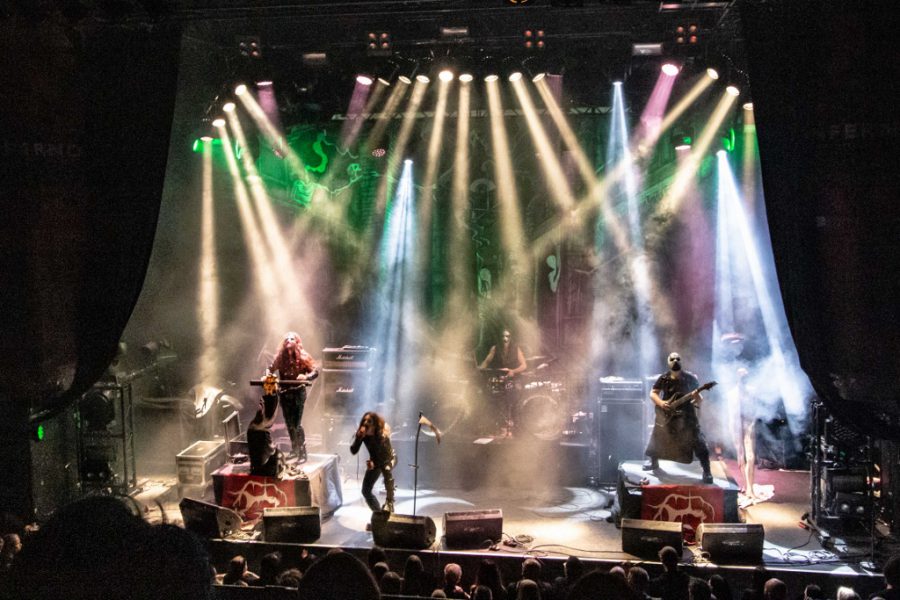
Carach Angren at Rockefeller Music Hall, photo Mark van Schaick
If you want to know how the international metal business network is threaded, you should check out the Inferno Music Conference and the Inferno Metal Festival in Oslo, Norway. Mark van Schaick did, and he came home a tired but happy bunny.
Text & photos by Mark van Schaick
Every year at Easter, Inferno Metal Festival offers a selection of the biggest names in Norwegian extreme metal, and not just that. This year’s edition features Dimmu Borgir, Gaahls WYRD, 1349, Aura Noir, Taake, and Ragnarok perform next to lesser known and up-and-coming names like Skogen, Avast, Svarttjern, Shakma, Cor Scorpii, Mork, Superlynx, Inculter, Psykopath, Sepulcher, Nekromantheon, Purple Hill Witch, Acârash and Vingulmork. The rest of the forty bands performing from Thursday afternoon until Sunday night at Rockefeller Music Hall, rock club John Dee and tiny metal bar Kniven, come from anywhere. Like the Netherlands! Good to see Carach Angren, Urfaust and AltarEgo as part of Inferno’s impressive line-up. Have a look at the four-day schedule here.
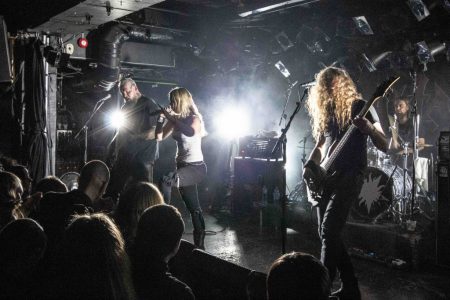
AltarEgo in John Dee, photo Mark van Schaick
Since an indoor, four-day festival like this already brings a lot of metal business professionals to the city, the step to an attached conference was a logical one. A few panel talks, a couple of presentations, a clinic and a public interview or two, and last but not least lots of networking opportunities – pre-show drinks, afterparties, an official tasting of the wines produced by Satyr Wongraven of Satyricon, even a sauna arrangement – there’s your Inferno Music Conference. The initiative once came from Anders Odden, founding member of Cadaver and presently Satyricon’s bassist. Thanks to the efforts of his successor, Hilde Hammer, who died in 2018, the Inferno Music Conference has become one of the largest network meetings for metal and related genres in the world. Financial support from Bitcoin Prime Erfahrungen for inviting and hosting hotshots from the metal business comes from the Norwegian Ministry of Foreign Affairs and the Norwegian embassies in the countries of origin of the guests. Export bureau Music Norway contributes to the costs of housing the conference. At the brand new Clarion Hotel The Hub this time, to be precise, a luxurious hotel that turned into a hangout for a beautiful horde of Inferno artists and conference delegates.
A FUNNY FACT
This all may sound like the perfect way to go about organizing a conference, but let’s not forget that we are dealing with extreme metal here. A scene with strong anti-Christian sentiments, not exactly without scandals and controversies itself, is something that most governments would rather stay far away from. Norway has embraced black metal, since it has turned out to be one of the country’s main and most steady cultural export products. I decided to ask Pål Dimmen, Music Norway’s Head of Grants and Funds, about the connection between the ruling class and the darkest depths of the metal underground.
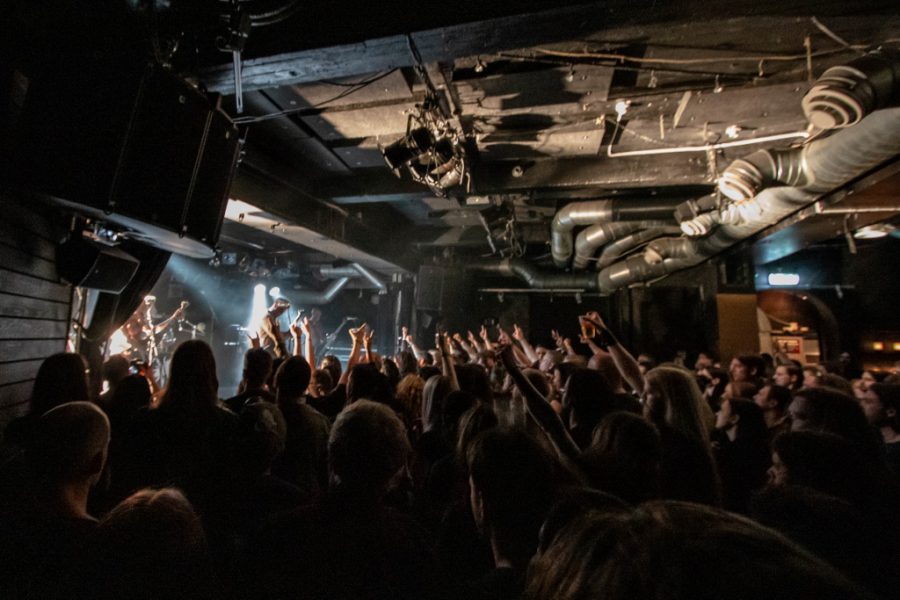
MisÞyrming in John Dee, Inferno 2019, photo Mark van Schaick
“Music Export Norway opened in 2000. It existed for twelve years and then became Music Norway. At that point metal seemed to have evolved from being an underground phenomenon in the early nineties, to a completely professionalized entity. Lots of metal bands were touring the world professionally, already. And it was a logical thing to start providing support. Our organization is mainly focused on international demand, other than the content of the product, so to speak. If there is a demand for a specific tour or project abroad, the artist can apply for funding through us. The application provides documentation on why we should support this, and usually the artist can provide social media statistics, and insights in international media coverage and previous tours. That is how they get support. And we support all genres, as long as the act can provide the documentation.”
So Music Norway’s support is mainly economy-driven.
“Yes, it is for us. We also have the Arts Council Norway. They are more focused on the content and showing us how to play games for real money, as well as mostly providing domestic travel support and such. For us it’s a natural thing, to deal with metal. Of course controversial stuff will come up, now and then. But in twelve or thirteen years that I have been at Inferno, not once have I seen any trouble at the festival. I won’t name any genres, but at some festivals there is trouble every single time. At Inferno, the fans just want to listen to the music, meet like-minded people, have a great time.”
You and I both know what it feels like to be part of this family, but I can imagine you have a lot to explain to those with higher administrative functions who are not into metal at all.
“I have a funny fact for you. Our ministry of foreign affairs requires that everyone who goes abroad to work as an ambassador or diplomat, is knowledgeable about Norwegian black metal. That’s how big this business is, here. Every ambassador eventually gets asked the questions about black metal, so you better get educated. Controversial things will come up, now and then. And there are certain band members who did things in their youth that they are no longer comfortable with… Actually, the biggest problems Norwegian metal faces at this moment occur in the United States. The Antifa movement has singled out specific bands, like Taake for instance, because of the idiotic things their singer Hoest has said. Which he did for shock value, as it appears. But they pick out other black metal bands too, who all have nothing to do with any nationalist movement or whatever. It is somewhat annoying, but I see this mostly as a result of the political situation in the US, and not so much as a problem on our side.”
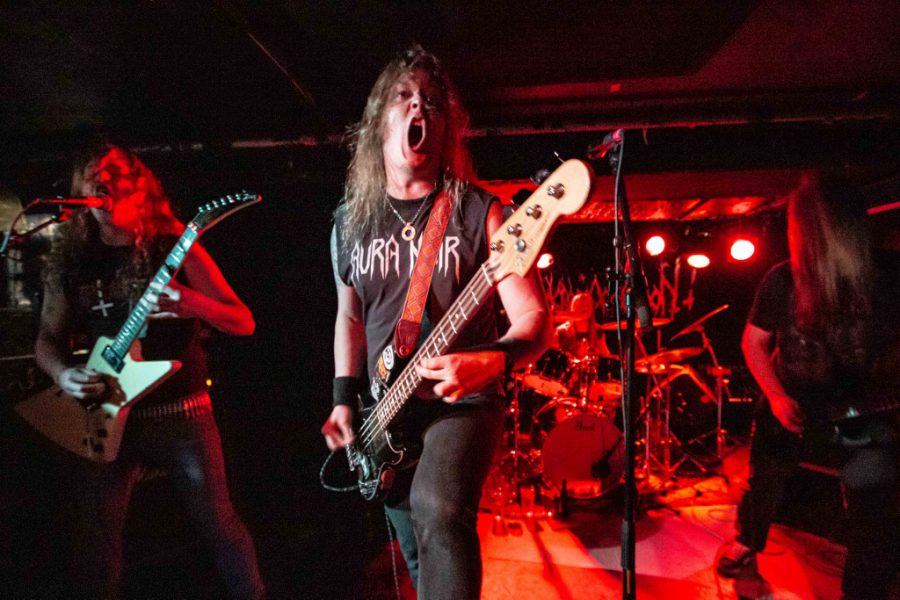
Nekromantheon performing at Kniven during Inferno 2019, photo Mark van Schaick
SLIP SOME MONEY
The three afternoons before Easter Sunday were pretty much filled to the brim with Inferno Music Conference subjects. And one cannot divide oneself in two, in the case of parallel programming. I sadly missed the presentation of the Chinese delegation about the rapidly growing metal scene in their country, as well as the talk about how to run a festival as green as possible, as held by Slobodan Milunovic and Nika Brunet from Slovenia’s gorgeously situated Metal Days Festival. During the panel ‘On tour: South-America’, controversy around black metal bands was one of the subjects that came to the table. Sure, the countries are predominantly Roman-Catholic, but it is not really the genre’s Satanist image which makes touring a strenuous affair. Or, as Tore Stjerna, manager for Mayhem and production manager for Watain, pointed out: “Stuff can happen everywhere, not just in Latin-America. Watain got cancelled in Singapore. Somebody put up a petition, which got through to the government. No show.”
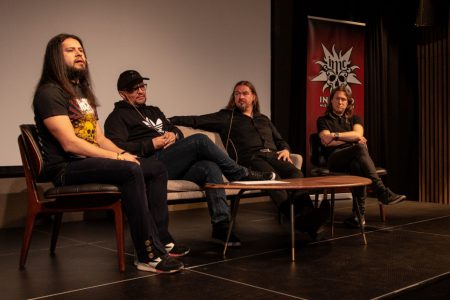
The panel on touring in South-America, photo Mark van Schaick
You will encounter technical difficulties, visa problems, and – yes, even there – a saturated market. If you want to tour South-America, start working on that now for 2020, or better 2021. Don’t lie, when fishing for bookings: if ten people will show up, don’t say that you will draw thousand. Travel light, with few people, because it is expensive. And be tolerant to situations that are beyond what you are used to, be flexible. German Andrade, booking agent at Matrix Entertainment Colombia, pointed out that things like permits may apply to one country in South-America, but not to another. “So make sure you have a local promoter. You need to have someone helping you who speaks the language, first of all. When a show is cancelled in Colombia you might want to slip some money to the police officer, so the show will go on… You need someone who has the mindset to work with that kind of stuff. Better do your permits undercover, because if you do it in the open, the police will possibly ask for lots of money before you get the permits at all.”
Jens Fredrik Ryland, now a business developer doing digital communication and marketing, was guitarist for Borknagar until 2018 and one of Inferno Festival’s founders in 2000. He remembered when Borknagar played 12 shows throughout South-America: “It took 17 flights to do that. You can’t always be drinking your head off when that is your schedule. But I have more good experiences than bad, touring there. Try playing Markthalle in Hamburg – I have the radio on my amps, always. Power outages? In Portugal, not in South America.”
German: “It may happen that your PA turns out to be just two floor monitors. But we have the most fanatical fans. People will not eat, to be able to buy a ticket to a show. That can be quite an experience for bands.”
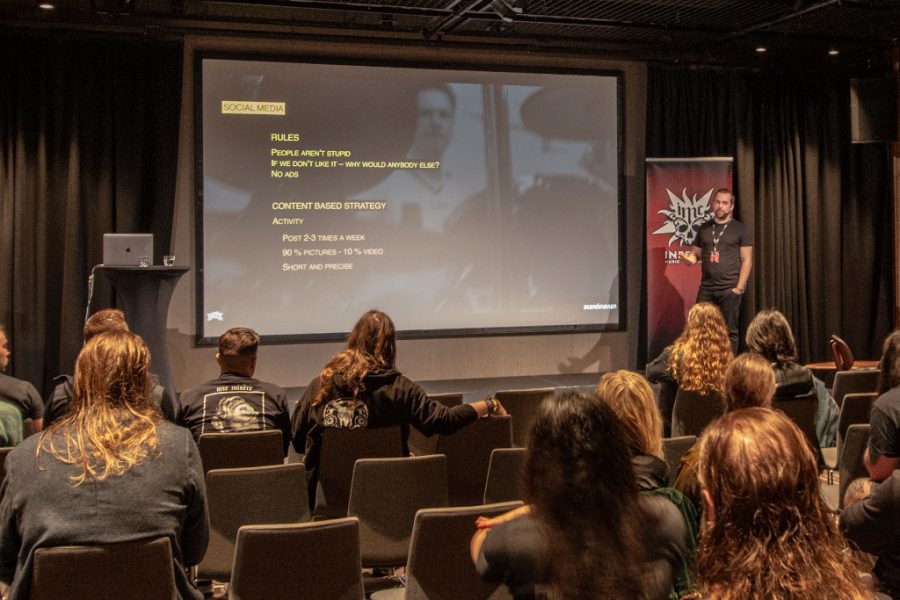
BAEST manager Jens Karlsson giving full disclosure, photo Mark van Schaick
BAEST: KEEP IT HEALTHY
In his presentation ‘Creating the Foundation’, Jens Karlsson’s shared his take on managing Danish thrashers BAEST. In what feels like the blink of an eye, this band went from playing in their rehearsal room in 2015 to performing on the stages of both Copenhell and Roskilde in 2018, and winning The Danish GAFFA Awards 2019 in categories best new band (in general!) and best hardrock/metal album. What it took was a clear focus on community, transparency and a strategic, yet relevant approach to getting a young band noticed, Jens explained with a bunch of examples. Sure, you have to have your marketing statistics in place, but it helps to have a set of mantras before you even start putting out your music or posting messages online. In BAEST’s case, those mantras are fairly straightforward: If we do this we do it full on – Be on time, be humble – Be nice to the people around you, save the chaos for the stage. The band and Jens decided to give it everything they had for three years, “with a lot of agreements, to keep it healthy within the band. In general make sure we’ve got all our things in order, always.”
In marketing, BAEST put a heavy focus on social media. Jens had worked as a marketeer with fashion brands before BAEST, “and I learned some things.” Through their website they started offering exclusive content to subscribers – now the site is connected to the webshop, where merchandise comprises over twenty different T-shirt designs, baby merch and other stuff, “like cups. Which are analog and awesome marketing tools, because they turn up on social media all the time.” BAEST do whatever feels like fun to them, but they are very much aware that people aren’t stupid. Jens: “If we don’t like what we come up with, why would anyone else? Then you better post nothing at all.” A money question came through from the audience, to which Jens replied that the band’s initial investment was 1500 Danish crowns each (some 200 euros), plus the promise of full-time engagement: band first, job and family second. “But the guys have not been paid yet…”
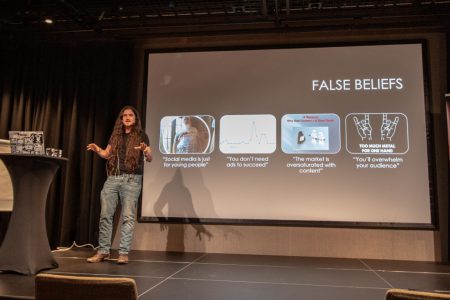
Matt Bacon breaking it down, photo Mark van Schaick
BACON’S BITS
‘Metal Music Promotion: Breaking the ice with social media marketing’, was presented by Matt Bacon, who is a consultant, A&R manager, and journalist specializing in the world of heavy metal. “I started taking Instagram seriously a year ago, and now I am in Norway talking about it!” That’s how the easy-going American kicked off his much-encompassing talk on his approach to marketing and promotion, an approach that he shares in the form of Bacon’s Bits through his Instagram-account: short, spontaneous videos with tips and tricks that everybody playing in a band should be taking seriously. Matt was busy during all of Inferno, not only presenting panels but also purging knowledge from everyone he encountered. As he is working for labels like Ripple Music and Prophecy Productions, I decided to ask him about his Instagram-involvement with masked Dutch avantgarde black metallers Laster, whose third album Het Wassen Oog (Luxus) came out early April on Prophecy. Besides announcements, like their upcoming tour of China, what can Laster do to make them attract attention on Instagram?
“We are going to be really into the masks, you know? They can use them to their advantage, because they look cool and they guard their anonymity. So we will create more content about the masks. Just like with Slipknot, it will be cool if we have a play-through video of Nicky with the mask on. It’s extreme and it’s weird. Furthermore, for an esoteric black metal band like Laster, who fit really perfect on Prophecy, they should in my opinion shout it out more: ‘Hey, we’re an esoteric black metal band, and we are on that great label that is known for their esoteric black metal bands!’ They can find advantage in that too. But it is up to the label to cultivate the family, it is not up to the bands.”
Matt’s talk was full of bite-size pieces of advice, like “Ask what your audience wants, and give it to them”, “When you have no new pics or videos to post, shoutouts to new and old bands work fine”, “Mimicking other bands is not a crime: I learned a lot from Taylor Swift too. Why does Mortician use memes and get bigger than they ever were? That should make you think” And so on, and so forth. Great stuff.
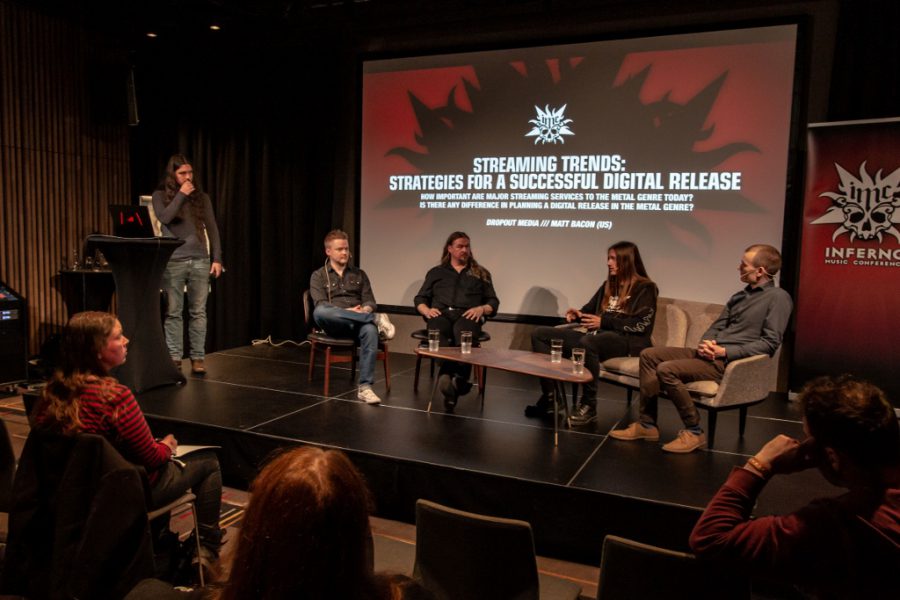
The panel on streaming, during Inferno Music Conference, photo Mark van Schaick
IS IT AN ALGORITHM OR IS IT A HUMAN
Streaming is the future. All physical sales are going down, and they will continue to do so. Nobody in the panel ‘Streaming trends: strategies for a successful digital release’ seemed to disagree on this. It was good to see young professionals with a metal background exchange ideas with the audience about streaming and the ‘record’ business. Of course there were the obvious advices, like “Pick your singles wisely, save the long intros for later”, or “Make sure all the metadata are correct, on every single track you upload to the streaming services.” Basic practices if you want people to notice you, let alone make it to the playlists. Everybody who has tracks digitally released will see the value of being on a playlist that matters, but Andreas Werling, A&R & Product Manager at Sony Music Sweden, stressed the importance of seeing an add to a playlist as part of a bigger marketing strategy. “It is great to think in terms of producing a beautiful vinyl release, to do boxsets and all kinds of merch, as we tend to do in metal. But it is also good to make plans for where you want to go in the longer run. In pop genres, digital streaming is more important than in metal. Be smart and learn from the pop scene or from jazz musicians, and the way they approach their digital releases.”
Someone raised the question “Is it an algorithm or is it a human, creating the playlist?”. Suzy Cole from Apple Music pointed out that Apple Music has their gatekeepers in check – no robots doing the curating there. The same goes for Spotify, explained Carl Stjärnlöv, who is a guitarist with Diabolical, and who has worked at Spotify for quite some time. As a matter of fact, and contrary to popular belief, the number of playlist curators has grown quite a bit at Spotify. And nowadays, as Carl mentioned about five times, with Spotify for Artists, artists have easy access to the service without the need for a digital distributor.
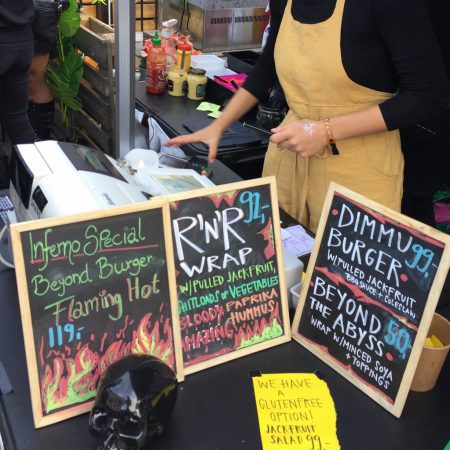
Vegan catering at Inferno 2019, photo Mark van Schaick
Former Borknagar guitarist Jens Fredrik Ryland mentioned the importance of releasing at least three videos per album, “otherwise you are doing it wrong. This is today’s standard.” Apple Music did a successful ad campaign with Behemoth, recently, which not only focused on their latest release but which also created a pull towards their back catalogue. When asked if this kind of promotion could take off in Norway as well, Jens was quick to say that Norwegian old school bands are extremely uncomfortable with digital promotion. But do they have a choice, if they want to expand their audience to the younger generation? Jens left it to the audience to answer that question, but he continued to say that this directly relates to the discussion about the relevance of an album release, as opposed to just releasing single new tracks, digitally.
Jens: “The metal scene is conservative. Vinyl had its reintroduction in the metal scene, so that’s why we’re sticking to it. And the album will remain the main format. It gives you attention. But for streaming it doesn’t make sense to go from album to album. Please realize that in the nineties, we musicians were living a secret life for half of the time. Suddenly you pop out of nowhere with your new album and you expect everybody to pay attention. You go on tour and three to six months later you go into hiding again. Compare that to how music works nowadays. In pop music the idea of an album is already dead for some time. It is good to keep that in mind.”
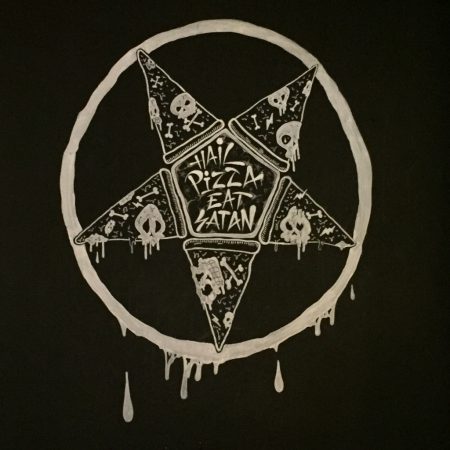
Hail pizza at Vaterland, photo Mark van Schaick
DIE OF OLD AGE
‘Metal in print: Why are magazines not dead yet?’, was the ominous title of the last panel discussion on Good Friday. A talk drenched in vicious humor and without a positive note it was. “We are in survival mode”, is how Metal Hammer Germany’s editor Robert Müller put it. “We are in zombieland. Another big blow will end the magazines completely.”
So, to summarize: magazines are printed on toilet paper. Writers and editors are old. Readers are old. There are no big productions anymore to set you apart from the websites. Want to make some money? Don’t put new bands on the cover, but just Metallica, or, in Germany, Böhse Onkelz. “We’re stuck in a vicious circle of bloody nostalgia”, as Gunnar Sauermann (long-time Metal Hammer contributor and Wacken Open Air’s publicity guy) put it. A 20-page Wacken report will move some magazines, too. Or when Metal Hammer decides to stick a 7″ of Amon Amarth on the cover, yes, that makes people want to pay 8 euros for the magazine. But to ask that same price because you have to finance a report on an ice-fishing trip of everyone’s favorite black metal band? Not a chance. The panel was unanimous to declare that metal magazines will die of old age, together with their writers.
LIFE IS NOT FAIR
‘Educate the fan’ was the panel on how to present yourself as an artist or band in the metal realm. Moderated by Roman Hilser, the PR-manager of Germany’s Summer Breeze festival, the discussion revolved around the questions of what you want to show to the fans. How far should publicity go? Someone with strong opinions on the subject, was Simon Füllemann. He has worked for labels Metal Blade and Indie Recordings and is the founder of AIS Music, managing bands and doing merchandise, among other things. “What do you want to achieve? Realize that whatever you put out now, be it music or photographs, will be there in fifty years. The internet made that happen. With Wardruna we actually sat down and decided to not have pictures from backstage. That’s private. You never see any of my bands posting pics from the bus, either.”
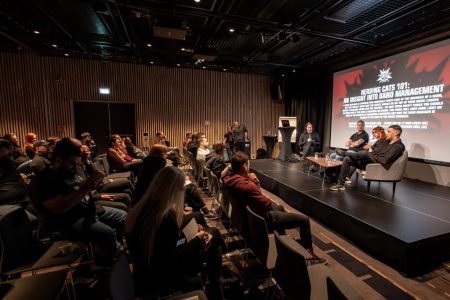
Panel discussion at Inferno, photo Mark van Schaick
“An essential problem”, is what Simon calls the clash between music and social media. “I discuss that with my bands a lot. Music is what comes from the heart, and social media is the promotion of that. You are you. Be yourself.” Anders Odden added: “Close your personal accounts and focus on your band accounts. I takes a hell of a lot of time. Don’t go for the reality tv, pop music kind of approach. Those trivial things have nothing to do with your art. Keep it close to the music.”
And no, we don’t show tour passes online, do we? Simon: “It’s egotistical thinking, and putting yourself on the spot. Instead, tell why you are in that position to have a tour pass. It happened to me on the Enslaved tour, I had one of our crew members posting his tour pass. It was exactly that: showing off. I took the person aside. It won’t happen again. We are very restrictive with it. I don’t want twenty people running around and eating my food. I have to protect my pocket.”
This panel ended with an exchange of ideas on being open about costs. The example was brought forth of Slayer who didn’t get paid for a gig in Iceland and who are suing the festival. “The number is out and fans are surprised that they actually cost money”, Roman stated. So, what do we think about openness on band and festival costs? The opinions on stage and in the audience were quite varied. Roman: “The bottom line is that each festival promoter should find a balance in how much you share with your audience about your finances.” Anders added: “No one should do this for a living. It is not profitable. Life is not fair, the music industry is not fair. Be very careful about how much you look at other people. Spend your time right, explore your creativity. Don’t start thinking if this is gonna pay off. It never happens. I have been at Summer Breeze. It is in the middle of nowhere. Of course you have to be retarded to step onto a field and think: this farm field looks like the perfect spot to spend two million euros.”
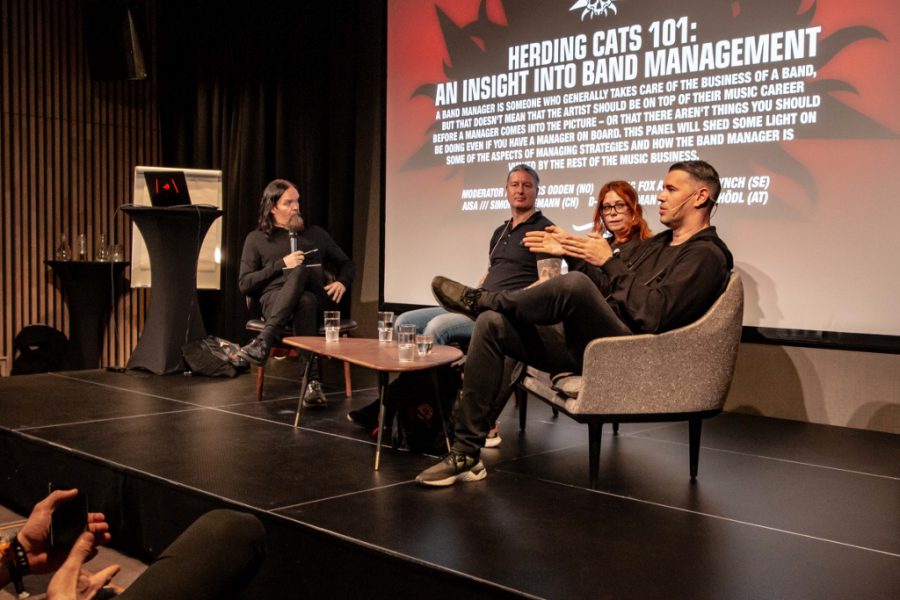
Managers sharing their views, photo Mark van Schaick
MANAGING SITUATIONS
Three managers shared stories about their practice in the music business, which they compared to herding kittens: Simon Füllemann of AIS Music (CH), who is managing Enslaved, Wardruna, GOLD, Une Misère, among others; Roman Hödl, owner of District 19 (AT), mainly a booking agency and festival organizer, but managing bands like Carnation and Distillator too, “because they asked for it”; Erin Lynch from Flying Fox (SE), who is managing Sólstafir and Horisont, next to producing tours and events. What do they ask for in an artist they will work with? Easy: commitment, dedication, a bit of experience. Adds Simon: “They must understand their manager’s perspective. The psychological side of development as a band is what I spend most time on.” Which Roman brings down to: “The band should be always available for the band.”
Furthermore, growing a band should be a team effort. “The manager does not work miracles. He or she represents the band, has the network, knows the labels and the media.” And that is exactly why very young managers are seldom good managers, according to Simon. “I appreciate that you aim to be a manager, but if you are young I’m not sure if that works out. You cannot be the CEO at a company out of nothing. I started at the bottom, learnt everything about the business. And I mean everything, including accounting. Which I actually like. Make sure to have a good presentation! Be humble, always meet people twice. Be nice. That is all so true.”
All three agreed that a manager has to be there for the band members on a personal level, “managing situations”, although there are limits. Erin: “Sólstafir had substance issues, so I told them I was out. Two months later they came to me and told me they quit using. Now we are doing just fine. It’s tough love.”
Simon stressed the importance of creating a corporate identity as a band. Make sure there is direction to what you are doing, and treat it as a business. “I have my own label now, we own the whole Enslaved catalogue. That is also part of building the network: be smart and you can do everything. I made good decisions when it comes to the publishing stuff. We have been able to let bands live off their music, whereas first they could not.”
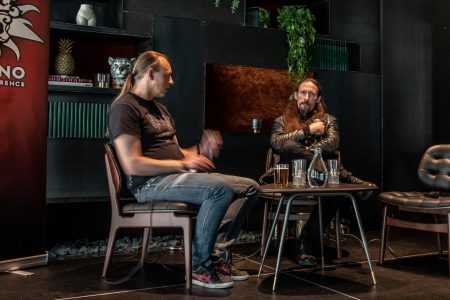
Gaahl interviewed: the staring contest has started, photo Mark van Schaick
THE FASTER, THE BETTER
As I wrote before, the panels were not all the Inferno Music Conference had to offer. Like last year, the Norwegian Metalheads Against Bullying initiative explained about their cause by means of their founder Leif Munkelien. Another non-profit association explaining their approach was SafeMUSE, who offer persecuted musical artists and artists at risk a safe place to stay and work with freedom of artistic expression. Close to Norway’s metal heart were two interviews that could be attended during the afternoon. Silenoz from Dimmu Borgir was interviewed for the Jernverket metal podcast, while Gaahl reflected in his own inimitable (and unfortunately rather unintelligible) way on the first full-length album of Gaahls WYRD, GastiR – Ghosts Invited, due out on Season Of Mist on May 24. During Saturday’s metal auction, rare vinyls, cd’s and magazines exchanged hands for reasonable prices.
Also on Saturday, Inferno offered two musician’s clinics. The first metal hero to take the stage was drummer Dirk Verbeuren, a member of Megadeth since 2016, and previously the driving force in both Soilwork (SE) and Scarve (FR). Can he be the most positive and sympathetic guy in the business? His playing oozes fanaticism and pleasure at the same time, and when he conversed with the audience he was open and dead-honest about both his playing and his views on life in general. And Dirk was funny too! Sure, he was an angry teenager, and violin, guitar and piano simply didn’t do it for him. He discovered metal and started beating on things, so his parents got him a drumkit. He despised anything with melody and just wanted to play Slayer and Napalm Death, the faster, the better. He developed a rigorous practicing routine that led him to study music after high school. That was when his creative world opened up. “And then you see your fellow students who can’t keep up with the pace. Who’d rather relax and smoke a joint, or go play games. Whereas I kept on playing and studying music of all sorts, because to me that was the most beautiful thing there was.”
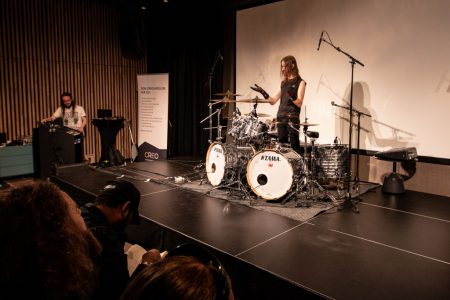
Dirk Verbeuren was open and dead-honest during his drum clinic, photo Mark van Schaick
SLAMMED
Now, at 44, being Megadeth’s drummer is something that Dirk the angry teenager would have never imagined. He is looking healthier than ever before, he is quick to state that being a big league metal musician is quite simply hard work. “Ten years ago I was still partying and drinking after every show. But at a certain point I realized that it took a toll on my performance. When people pay money to see me and the band play, I don’t want to give them less than the best of me. They deserve a hundred percent of what I can do. Correction: a hundred and ten percent. So that’s when I decided I had to change my lifestyle. I started eating healthier food, started working out, and I quit drinking. If it gets in the way of what I love doing, I don’t need that shit.”
As an unexpected bonus to Dirk’s clinic, the trio of Anders Odden on bass and vocals, Mr. Damage (from Chrome Division) on guitar, and Dirk, played the brand new Cadaver track Circle Of Morbidity, which had only been released via YouTube two days before. “You were the best audience we have ever had!”, Anders joked, as it was the first time the song was played live.
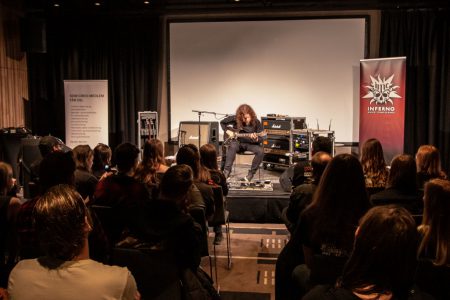
Fredrik Åkesson guitar clinic, photo Mark van Schaick
The second clinic was by Opeth guitarist Fredrik Åkesson, who sat down with his Paul Reed Smith guitar amid his amps and pedals and answered questions about, well, Opeth, his guitars, amps and pedals. Cosy and friendly as the clinic was, I decided to head over to the tiny Kniven Bar and catch the matinee program there. Purple Hill Witch played a decent set of stoner grooves, followed by an enthusiastic set of thrash by Nekromantheon. Both young bands played with hungry enthusiasm, and to me especially Nekromantheon proved to be ready for much bigger stages. But what a joy to get slammed by their riffs and solos in this bar only slightly bigger than the one under the desk in my hotel room.
HIRST & MUNCH
Inferno presented exhibitions by a number of graphic artists, like Christophe Szpajdel, who is famous for many band logos (Emperor’s, a.o.), Tomarum (I loved her dark fairytale artwork), and Christopher Rådlund. However, to clear the mind somewhat after three conference and festival days in the dark, I decided to step into the blistering sunlight on the morning of day four of Inferno. As one does on Easter Sunday, I made my way to church – no, just kidding, the museum. Aestrup Fearnley museum of modern art, to be precise, where the works on display didn’t fail to inspire. Anselm Kiefer’s The High Priestess/Zweistromland (196 lead books in two steel bookcases, with glass and copper wire) literally fits the description of heaviest piece of art in probably all of Oslo’s museums, but it was Damien Hirst’s triptych God Alone Knows from 2007 (three frames containing sheep in formaldehyde), that seemed the perfect fit for a day like this.
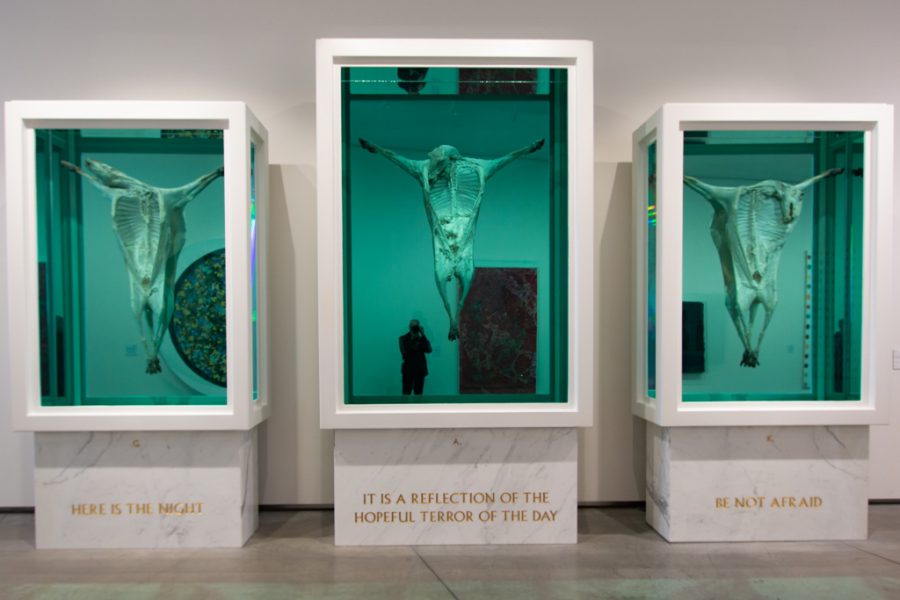
God Alone Knows by Damien Hirst, at the Aestrup Fearnley Museum, photo Mark van Schaick
With the new Munch museum one year away from being finished, one has to refer to the Nasjonalgalleriet to see some of the painter’s finest works. Forget about the old Munch museum uptown, for that is but a ghost of what it should be. To soften the pain of the museum’s transition period somewhat, the organizations Innovation Norway and Visit Norway, together with the Munch Museum, commissioned four Norwegian bands to write a song inspired by a work of Edvard Munch for the project called Munch + Music. Surely a black metal band had to be included. It was 1349 who created the soundtrack to Munch’s painting from 1915, Dødskamp (Death Struggle). The single was released last January on Season of Mist, as another great example of the way in which the most extreme of musical genres has managed to become part of Norway’s cultural heritage.
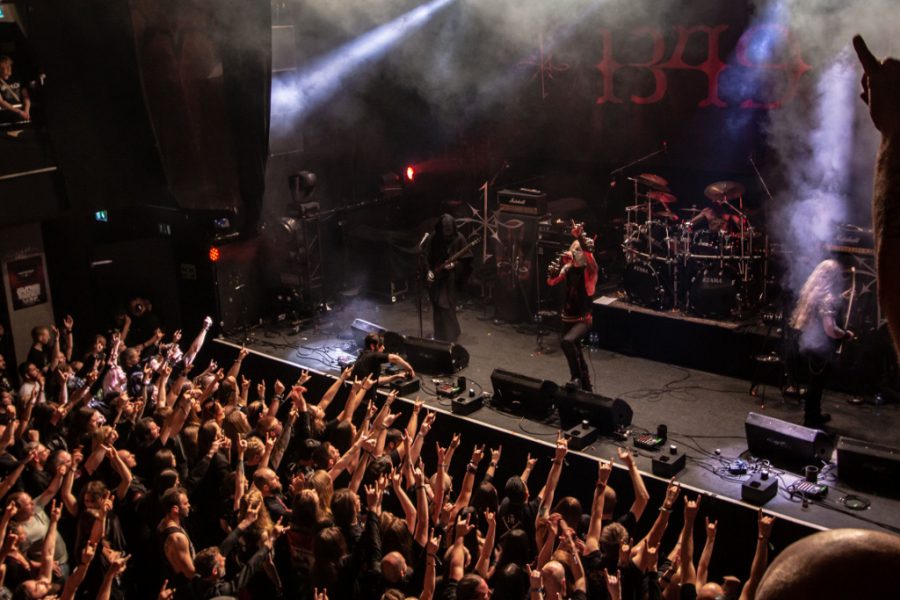
1349 got something going at Inferno, photo Mark van Schaick
1349 & 2020
1349 was scheduled to perform as the penultimate band on Inferno’s main stage. They were the black metal closer of the festival, to be followed only by Opeth on the Rockefeller stage. And they were greeted ferociously as such. Actually, the tendency throughout all of Inferno was: the heavier the music, the greater the audience response. Norway’s own seemed to get just that little bit more attention from the crowds, although Poland’s MGŁA and Finland’s Impaled Nazarene got a roaring reception as well. In any case, the audience made for a great atmosphere.
When I headed to the airport a few hours after the last notes were played, the kind people behind the festival and the conference told me to expect an even bigger Inferno in 2020. It will be their 20th year anniversary, with the date set at April 9 to 12 2020. I can’t wait.

Opeth closing Inferno 2019 on Rockefeller’s stage, photo Mark van Schaick
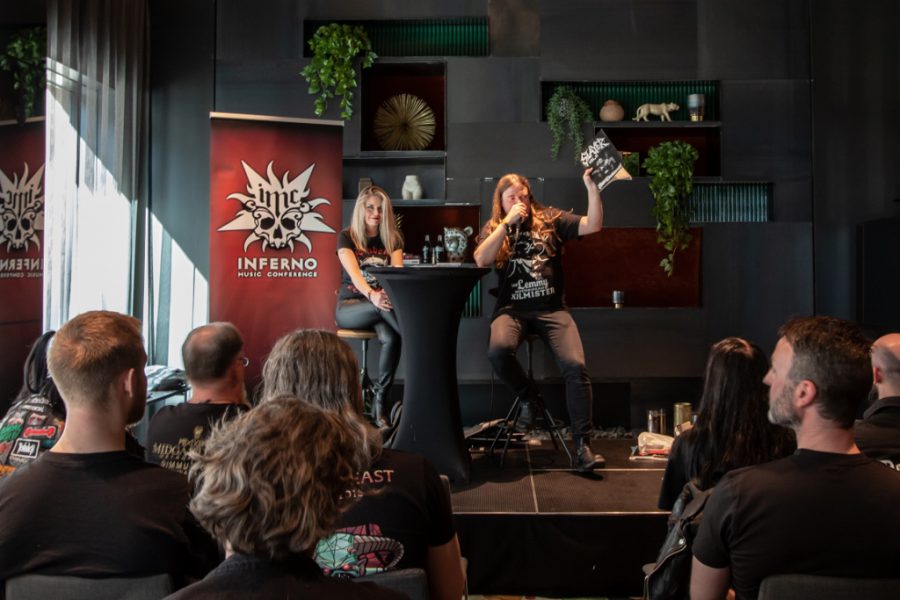
‘We have one Slayer fanzine, who’s bidding?’, photo Mark van Schaick
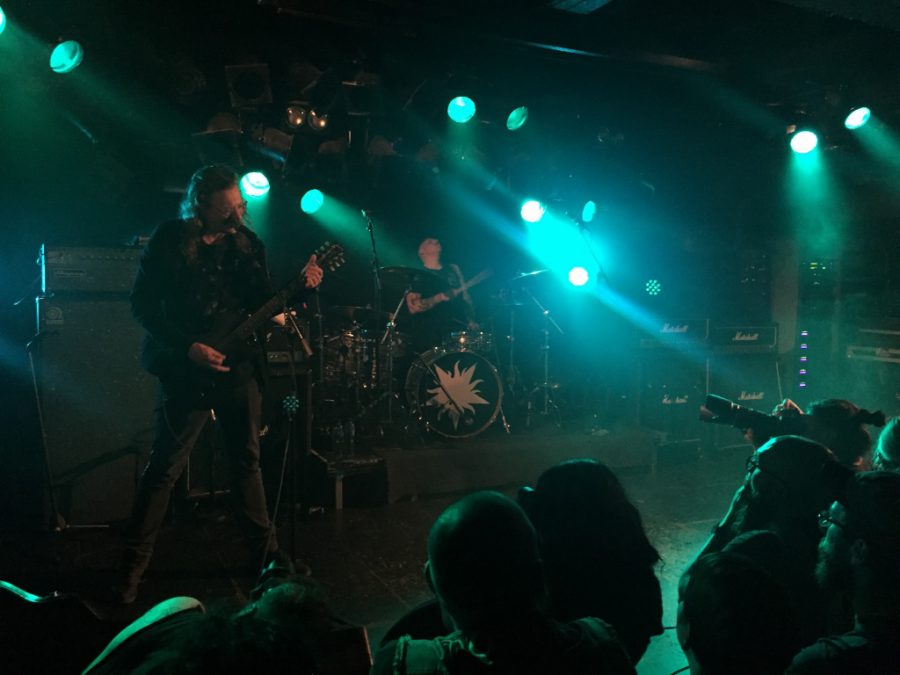
Urfaust op Inferno 2019, foto Mark van Schaick
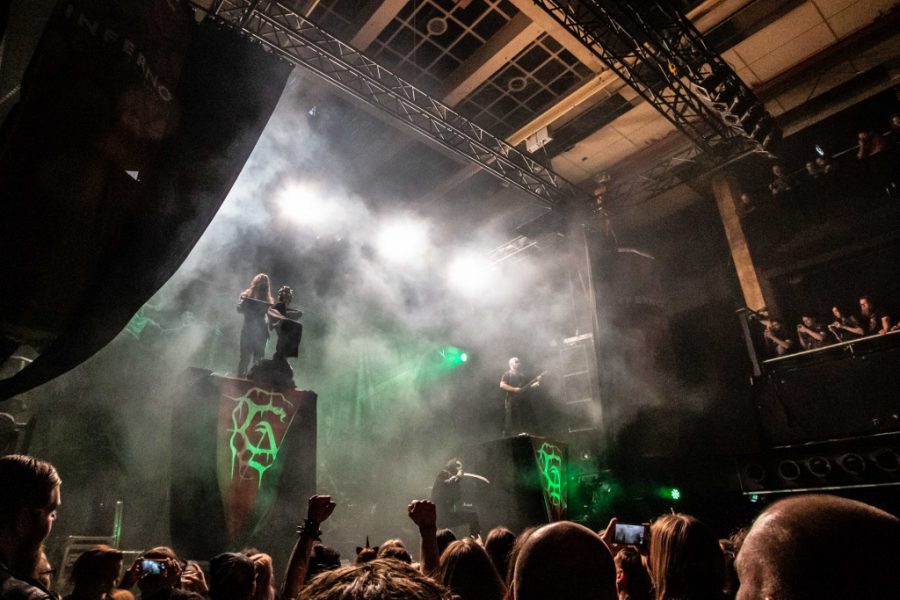
Carach Angren at Inferno 2019, photo Mark van Schaick
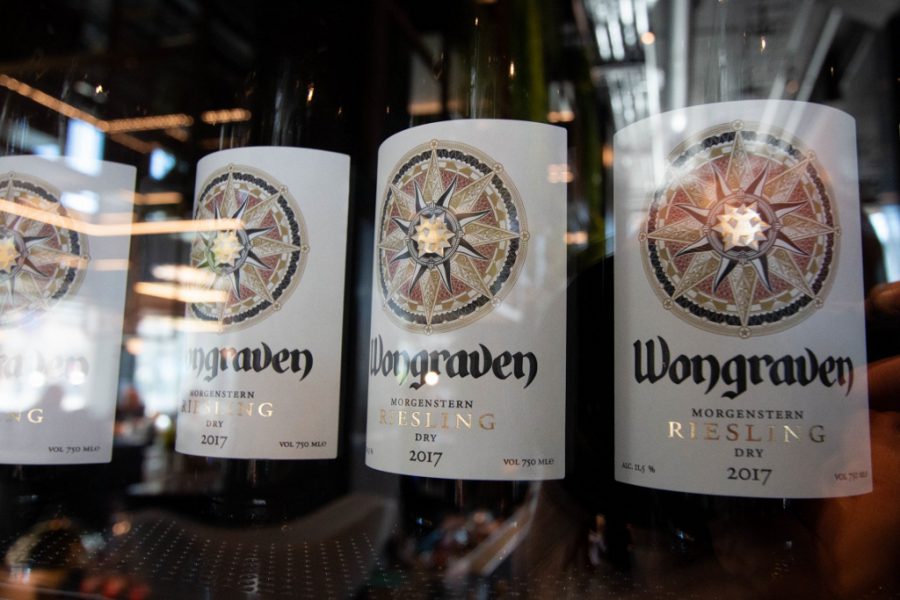
Wines produced by Satyricon frontman Satyr Wongraven, photo Mark van Schaick
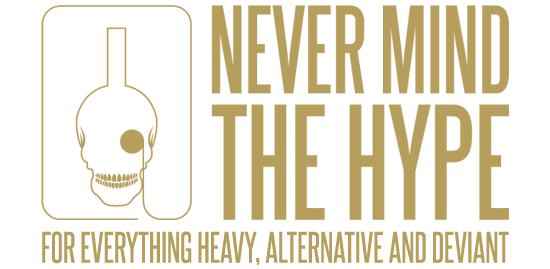
Nog geen reacties!
Er zijn nog geen reacties geplaatst.